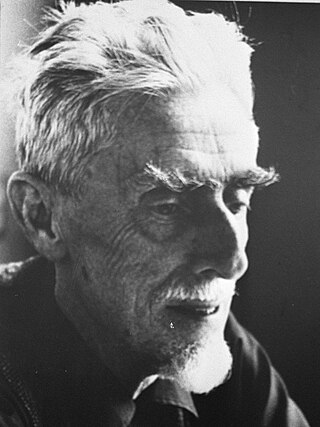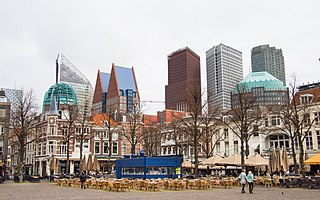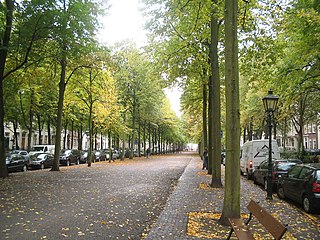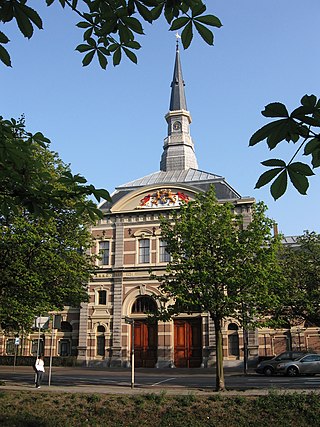
Maurits Cornelis Escher was a Dutch graphic artist who made woodcuts, lithographs, and mezzotints, many of which were inspired by mathematics. Despite wide popular interest, for most of his life Escher was neglected in the art world, even in his native Netherlands. He was 70 before a retrospective exhibition was held. In the late twentieth century, he became more widely appreciated, and in the twenty-first century he has been celebrated in exhibitions around the world.

The Hague is the capital city of the South Holland province of the Netherlands. With a population of over half a million, it is the third-largest city in the Netherlands. Situated on the west coast facing the North Sea, The Hague is the country's administrative centre and its seat of government, and while the official capital of the Netherlands is Amsterdam, The Hague has been described as the country's de facto capital since the time of the Dutch Republic.

Noordeinde Palace is one of three official palaces of the Dutch royal family. Located in the city center of The Hague in the province of South Holland, it has been used as the official workplace of King Willem-Alexander and Queen Maxima since 2013. The Noordeinde Palace and its surrounding palace grounds are property of the Dutch State.

The Hague School is a group of artists who lived and worked in The Hague between 1860 and 1890. Their work was heavily influenced by the realist painters of the French Barbizon school. The painters of the Hague school generally made use of relatively somber colors, which is why the Hague School is sometimes called the Gray School.

The Kunstmuseum Den Haag is an art museum in The Hague in the Netherlands, founded in 1866 as the Museum voor Moderne Kunst. Later, until 1998, it was known as Haags Gemeentemuseum, and until the end of September 2019 as Gemeentemuseum Den Haag. It has a collection of around 165,000 works, over many different forms of art. In particular, the Kunstmuseum is renowned for its large Mondrian collection, the largest in the world. Mondrian's last work, Victory Boogie-Woogie, is on display at the museum.
The Miniature Museum of Modern and Contemporary Art was founded by Ria and Lex Daniels in 1990. It was initially located at the AMC hospital in Amsterdam, but moved to the Kunstmuseum Den Haag in 2013, where it was on a long-term loan for five years.

Lange Voorhout Palace in The Hague was designed in 1760 by the architect Pieter de Swart for Anthony Patras (1718-1764), a deputy to the States General of the Netherlands.

Johann Heinrich Keller (1692–1765) was an 18th-century painter from Switzerland active in the Dutch Republic.

The Lange Voorhout is a street in the old city centre of The Hague, Netherlands. It is L-shaped and runs from Kneuterdijk in the west to Toernooiveld in the east, reaching approximately 0.47 kilometres (0.29 mi) in length.

Berend Strik is a Dutch visual artist working and living in Amsterdam.
The following is a timeline of the history of the municipality of The Hague, Netherlands,

KM21 is a museum for contemporary visual art in The Hague in the Netherlands. The museum was established in 2002 as part of the Kunstmuseum Den Haag. In KM21 work by artists from The Hague, the Netherlands and international contemporaries is exhibited.

The Koninklijke Schouwburg is a theater in the city center of The Hague. The theater was built in 1766 and has been in use as theater since 1804. From 2017 it is one of the theaters in use by the national theater company Het Nationale Theater, but also other companies perform in the Schouwburg.

Hotel Des Indes is a hotel located at the Lange Voorhout in The Hague, The Netherlands. It was constructed as a mansion in 1858. In 1881, it opened as a hotel.

The Fotomuseum Den Haag is a photography museum in The Hague. The museum was founded in 2002. It was a spin-off of the nearby Kunstmuseum Den Haag, when then director Wim van Krimpen decided that the Kunstmuseum's collection of photography had become so rich that it deserved a separate location. It shares an entrance and space with the museum of contemporary art KM21.

Jacob Coenraad Ritsema was a Dutch landscape, portrait and genre painter; associated with the Düsseldorfer Malerschule and the Haagse School.

The Royal Stables is a collection of equestrian stables of the Dutch royal family, the House of Orange-Nassau. It is a Rijksmonumental building that is part of the royal palace grounds located in the city center of The Hague in the Netherlands. The Noordeinde Palace and the Palace Gardens are also part of this same palace complex. The Noordeinde Palace and its grounds are the official workplace of the Dutch King Willem-Alexander.
The Embassy of Sweden, The Hague is the diplomatic mission of Sweden in The Hague. The Netherlands is the first country with which Sweden exchanged permanent ambassadors, a relationship established in 1614. The embassy's primary role is to monitor, represent, and advance Swedish interests within the Netherlands and international organizations based in The Hague. Its responsibilities include providing services to Swedish authorities, businesses, organizations, and citizens. The embassy regularly reports to the Ministry for Foreign Affairs in Stockholm, offering insights into political and economic developments, as well as the country's stance on global events. A key focus is promoting Swedish economic interests by aiding Swedish companies and attracting foreign investments to Sweden, collaborating closely with Business Sweden in The Hague and the Swedish Chamber of Commerce in Amsterdam. Additionally, the embassy handles consular matters. It also engages in promoting Sweden through seminars, exhibitions, and cultural events.

Allotments near The Hague is a painting by the Dutch artist Jacob Maris. It was executed around 1878, using oil on canvas, and is 62.5 by 54 centimetres. It depicts a then still undeveloped part of The Hague near Scheveningen. Painted in the style of The Hague School, the work is in the collection of the Kunstmuseum Den Haag.

The Haags Historisch Museum is a museum situated on the Korte Vijverberg in The Hague, Netherlands, dedicated to the history of the city. It is based in the one-time guild house of Saint Sebastian. In the seventeenth century, this guild house was the home of the civilian militia of Saint Sebastian, whose members are depicted in some of the museum collections.

















